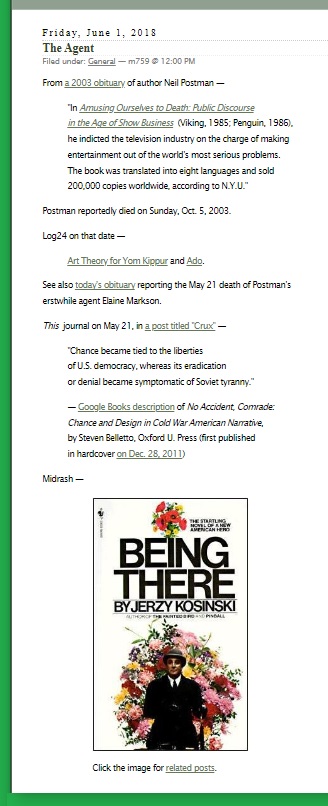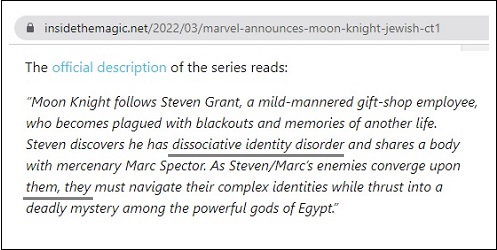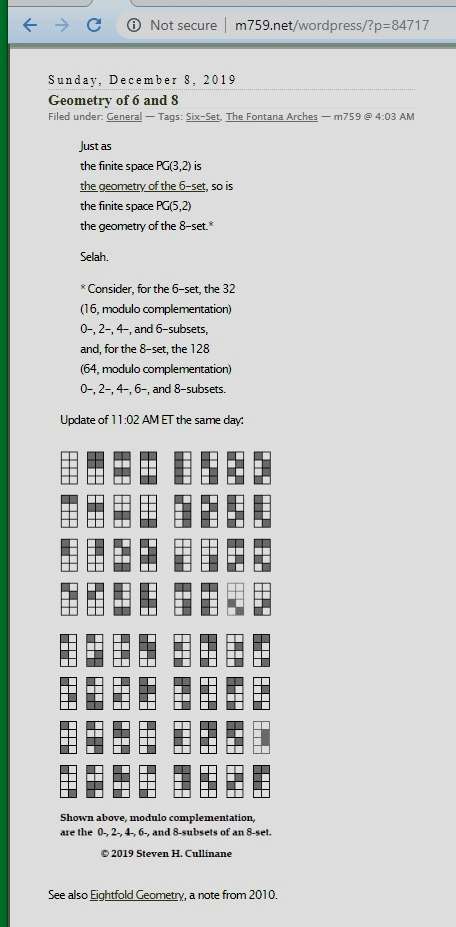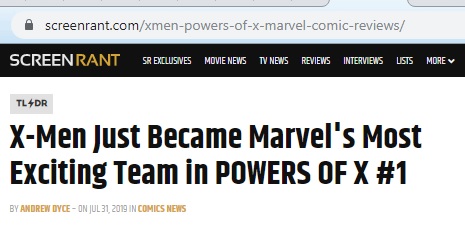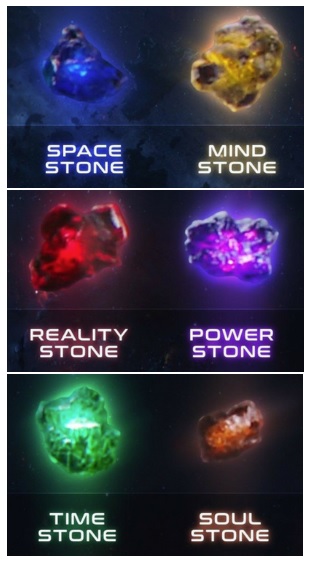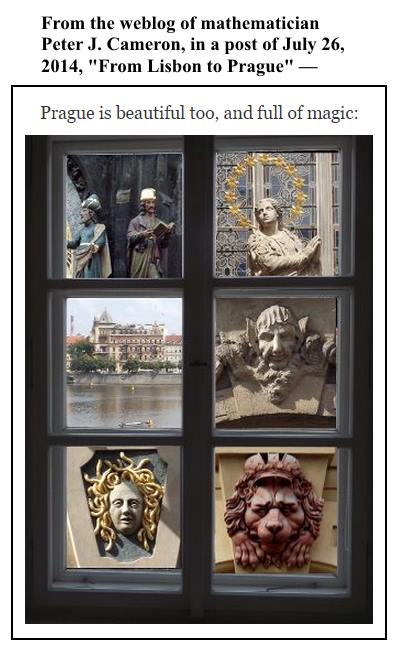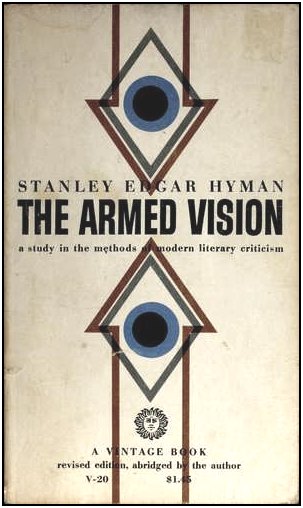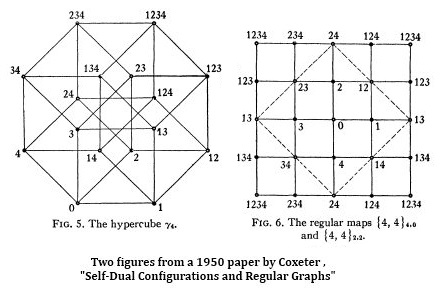From a search in this journal for Postman . . .
Sunday, September 25, 2022
Thursday, September 19, 2019
Saturday, June 9, 2018
Through Marvel Comics, Darkly
Click the above for "Cloak and Dagger" in this journal.
Monday, May 20, 2024
Wednesday, May 15, 2024
Transformer Problems (Before the Pretrained Ones)
Friday, April 26, 2024
Freeplay
"No doubt that by orienting and organizing the coherence
of the system, the center of a structure permits the Freeplay
of its elements inside the total form."
— Derrida in Wikipedia
"How's tricks, dangerous love triangle?"
The Source:

Related reading . . .
Krapp for HYDRA

Saturday, July 29, 2023
The Up Date
Dialogue from a poet's memorial —
– Exactly. Did you read my book?
– No, I’m sorry.
– That’s okay. This is marvellous.
– A first date like a game show.
– I didn’t mean to lecture.
– I’m sorry, I didn’t mean to call it a date.
Related documentation from my email today . . .

Sunday, February 5, 2023
Dimensions

A Logo for Riri —

The above Nick Romano passage is from Knock on Any Door,
a 1947 novel by Willard Motley. Another Motley novel about
Chicago, from 1958 . . .
|
Page 41 The city was a blue-black panther that slunk along beside them. The tall, skyscraper night-grass hemmed them in. The thousand neon animal eyes watched their going. Page 67 The blue-black panther of a city watched their going. The un- blinking neon animal eyes watched their going. Thousands of neon signs lit their way. In an alley behind West Madison Street half an Page 68 hour before, a bum, drunk, had frozen to death lying in the back doorway of a pawnshop. The blue-black panther crouched over him. Page 70 First the creak of ice as an automobile goes by. Then the frown into your room of the red brick building across the street, its windows frosted over like cold, unfriendly eyes. Then a bum stumbling along trying to keep warm. Now a drunk, unevenly. And the wind like the howling voice of the blue-black panther, hunting, finding. And the clanging of impersonal streetcars. And each bar of neon, cold, dead. No message. The clown takes his bow and it is Christmas Day. Page 79 The blue-black panther followed them, sniffing at their heels. Page 106 Above them the blue-black panther lay on the roof of a tenement house, its feline chin on the cornice, its yellow-green eyes staring down onto the black night street of Maxwell. Its tail, wagging slowly back and forth, was like a lasso, a noose, sending little shivers of pebbles rolling loosely across the roof. Page 154 Then he went down to the Shillelagh Club. Through the pane, in the crowded, noisy place, he saw her. She was sitting at a table near the back, alone. Her cigarette had fallen from her lips and rolled away from her on the table top. It had burned itself to a long gray ash. Her head hung loosely on her neck as if she was asleep. A half-empty glass of beer was in front of her. Please, Mother, please come out, he prayed to her. And he stood next door to the tavern, waiting, his small shoulders drawn in, his head down in shame. And often he walked to the window and stood on tiptoe. She was still there. In the same position. He waited. He would be late to school tomorrow. He waited, keeping the long vigil. He waited. Twelve years old. And the thousand neon-animal eyes stared at him savagely. He waited. The blue-black panther lashed out its tail, flicking its furry tip against his ankles. He waited. Page 250 Alongside the blue-black patrol wagon the blue-black panther walks majestically. Page 262 Outside the door the blue-black panther rubs its back like a house cat. Page 409 Nick held the cigarette listlessly. The smoke curled up his wrist and arm like a snake. The blue-black panther licked his hand. |
Friday, July 29, 2022
… From the Stadium
(A sequel to the previous post — "To the Lighthouse")
From that same date . . .
|
Log24 on August 5, 2002 — "To really know a subject you've got to learn a bit of its history." — John Baez, August 4, 2002
"We both know what memories can bring; — Joan Baez, April 1975 "Venn considered three discs R, S, and T as typical subsets of a set U. The intersections of these discs and their complements divide U into 8 nonoverlapping regions." — History of Mathematics at St. Andrews "Who would not be rapt by the thought of such marvels?" — Saint Bonaventure on the Trinity |
"Who would not be rapt?" . . . Cristin Milioti? —

Sunday, May 1, 2022
Jailbait Puzzle for Moon Knight


The pane number of interest — 15 or 14 ? —
depends on your perspective.
Related cinematic art of Oscar Isaac —

Wednesday, March 30, 2022
Wednesday, March 23, 2022
Watchmen Squid Game: Pronoun Trouble

|
"… Wade’s entire life is built around the squid attack. In the episode’s opening, we see that 34 years ago, young Wade was at a carnival in Hoboken, New Jersey, proselytizing as a Jehovah’s Witness when the squid emitted a psychic blast that killed three million people in the New York area. Just before the attack, a girl led him into a house of mirrors, feigning interest in hooking up with him in order to steal his clothes, leaving him naked and humiliated in the fairground attraction. But the cruel prank also saved his life, as mirrors can apparently repel the squid's psychic blast." |
Related literary remarks —
|
"It may have been by chance, and it may have had the side effect of being easy to read, but this way of putting a novel together offered a bridge between the miniaturist in Doerr and the seeker of world-spanning connections. He could focus on the details of every piece in the narrative, but there was pleasure, too, in placing them against each other. Sometimes he would lay out all these micro chapters on the floor so he could see them and discover the resonances between characters across space and time. 'That’s the real joy,' Doerr said, 'the visceral pleasure that comes from taking these stories, these lives, and intersecting them, braiding them.'" — "A version of this article appears in print on Sept. 20, 2021, Section C, Page 4 of the New York edition with the headline: Bringing His Readers To Higher Ground." |
Monday, January 31, 2022
The Prime Mover
"Metaphor in language — the prime mover"
— George Steiner in Real Presences (1989)
Not so prime —
See also the "Transformers" marketing saga.
Related marketing:
Disney Easter eggs —
Sunday, November 21, 2021
The Legend of the Disney Cheerleader
1 2 3 4
who are we for?
Friday, July 9, 2021
Sunday, June 27, 2021
Critical Space Race Theory
See as well the Kree vs. the Skrulls.
"… an abundance of types of spaces
can be an extremely confusing situation
to a beginner." — The late Martin Schechter
As can an abundance of types of races.
Monday, January 18, 2021
Interestingly
"Take out the papers and the trash"
—The first line of the song Yakety-Yak (1958).
Related cultural observation —
The above passage is from "The Matrix," a post of Nov. 23, 2017 —
Thursday, January 7, 2021
The Primes of Miss Jean Valentine
Valentine reportedly died on December 29, 2020.
Related dialogue from "The Mirror Has Two Faces" (1996) —
– It's interesting how coupling appears in nature and mathematics.
– You were talking about pairs …
– Oh, the twin-prime conjecture. It explores pairs of prime numbers.
Those only divisible by themselves. Three-five. Five-seven.
Not seven-nine …
– Nine can be divided by three.
– That's right. And … and so on. It was discovered that pairs were
often separated by …
– One number in between.
– Exactly. Did you read my book?
– No, I'm sorry.
– That's okay. This is marvellous.
– A first date like a game show.
– I didn't mean to lecture.
– I'm sorry, I didn't mean to call it a date.
Twin-Prime Dates —
December 31 and December 29, 2020.
"Though the Witch knew the Deep Magic, there is a magic deeper still
which she did not know. Her knowledge goes back only to the dawn
of time. But if she could have looked a little further back, into the
stillness and the darkness before Time dawned…she would have known
that when a willing victim who had committed no treachery was killed
in a traitor’s stead, the Table would crack and Death itself would start
working backwards."
– C. S. Lewis, The Lion, the Witch and the Wardrobe , as quoted at
https://apologyanalogy.com/death-working-backwards/ .
Monday, January 4, 2021
Enchantments
“Mr. Breuer’s audiences had to be willing to embrace,
or at least shrug off, some quantity of abstruseness
in his productions. Yet there was often a rapturous,
cacophonous beauty to them. At their best … they
worked on spectators like enchantments.
You can sense that effect in Margo Jefferson’s
New York Times review of “Red Beads” (2005) …
that she called ‘theater as sorcery; it is a crossroads
where artistic traditions meet to invent a marvelous
common language.’ “
— Laura Collins-Hughes, Jan. 4, 2021
I prefer . . .
Wednesday, June 3, 2020
Monday, March 30, 2020
Annals of Ugly Design
The Boston Globe Saturday on Friday's death of one of
the two architects of Boston City Hall —
A gifted storyteller, Mr. McKinnell liked to recount
the response of renowned architect Philip Johnson to
City Hall. “ ‘Absolutely marvelous. … I think it’s wonderful.
… And it’s so ugly!’ ” Mr. McKinnell told Pasnik, adding:
“We thought that was the greatest praise we could get.”
See more ugliness from this journal on Friday —
See also this journal on the death of the other City Hall architect.
Tuesday, December 10, 2019
Eternal Color
For the above title, see posts tagged Eternal Color.
From this evening's online New York Times —
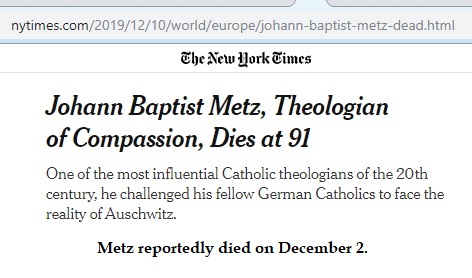
Related imaterial —

A scene from the film of the above book —


Friday, September 27, 2019
Algebra for Schoolgirls
The 15 points of the finite projective 3-space PG(3,2)
arranged in tetrahedral form:
The letter labels, but not the tetrahedral form,
are from The Axioms of Projective Geometry , by
Alfred North Whitehead (Cambridge U. Press, 1906).
The above space PG(3,2), because of its close association with
Kirkman's schoolgirl problem, might be called "schoolgirl space."
Screen Rant on July 31, 2019:
A Google Search sidebar this morning:
Apocalypse Soon! —
Wednesday, September 18, 2019
Powers of X
Screen Rant on July 31, 2019 —
The above space PG(3,2), because of its close association with
Kirkman's schoolgirl problem, might be called "schoolgirl space."
See as well a Log24 post from the above Screen Rant date —
The Perpetual Identity Crisis

"There is such a thing as a 4-set." — Saying adapted
from a 1962 young-adult novel.
Midrash — An image posted here on August 6 —

Saturday, September 7, 2019
Fury Road: Jukebox Hero*
"Fury: OK. Your turn. Prove you're not a Skrull.
[Carol calmly blasts energy out of her fists towards a jukebox
on the opposite side of the room before resting her head
back on her fist. Fury continues to look towards the jukebox,
both concerned and confused]
Fury: And how is that supposed to prove to me that you're not a Skrull?
Carol: It's a photon blast.
Fury: And…?
Carol: A Skrull can't do that. So a full-bird colonel turned spy turned
SHIELD agent must have pretty high security clearance. Where's Pegasus?
[The scene changes to a black car driving through an empty highway
next to a mountain, before changing to the inside of the car showing Fury
driving and Carol in the passenger seat]
Fury: So the Skrulls are alien races which infiltrate and overtake alien planets.
And you're a Kree, a race of noble warriors.
Carol: Heroes. Noble warrior heroes."
* See also this morning's post in memory of guitarist Jimmy Johnson,
as well as . . .
Wednesday, August 28, 2019
Influenz
Influenz , by Paul Klee —
"One of the most influential of modern thinkers . . . ."
As is Stan Lee . . .
"Watch the trailer." — This journal on Eliza Doolittle Day, 2012 .

Tuesday, August 6, 2019
Mathematics and Narrative: The Crosswicks Curse Continues.

"There is such a thing as a desktop."
— Saying adapted from a 1962 young-adult novel.
Saturday, May 18, 2019
Plan 9
|
NEWSWEEK
AT 95, HERMAN WOUK
BY LOUISA THOMAS ON 4/8/10 AT 8:00 PM EDT Still, Wouk, a month away from his 95th birthday, knows he cannot write forever. He has described The Language God Talks as a "summing up," even if he is toying with the idea of writing a sequel. Earnestly written and very brief, it is an unusual work—partly a quick trip through developments in cosmology, partly an episodic memoir, partly an essay on faith and science. At the end, it portrays an imagined conversation between Wouk and the scientist Richard Feynman: historical fiction about the drama of the believer and the skeptic. In real life, Wouk met Feynman while researching the atom bomb for War and Remembrance . Feynman wasn't interested in fiction; he called calculus "the language God talks." But during a summer at the Aspen Institute, the two men spent hours talking, and Wouk has been thinking about his exchanges with Feynman and other scientists ever since. He even tried to learn calculus. Feynman was a secular Jew, and yet something about the way he saw the world resonated with the observantly religious novelist. One day Wouk came across an interview in which Feynman said, "It doesn't seem to me that this fantastically marvelous universe … can merely be a stage so that God can watch human beings struggle for good and evil—which is the view that religion has. The stage is too big for the drama." The huge stage and the human drama: "This is the subject I've been thinking about my whole life," Wouk says. . . . . |
Related remarks on language —

Wednesday, May 1, 2019
For the First of May
"The purpose of mathematics cannot be derived from an activity
inferior to it but from a higher sphere of human activity, namely,
religion."

"The hint half guessed, the gift half understood, is Incarnation."
— T. S. Eliot in Four Quartets

See also Ultron Cube.
Sunday, March 17, 2019
Easily
"Watch the trailer." — This journal on Eliza Doolittle Day, 2012.

Midrash — March 14 remarks on geometry from Christchurch, New Zealand —
Monday, March 11, 2019
Overarching Metanarratives
See also "Overarching + Tesseract" in this journal. From the results
of that search, some context for the "inscape" of the previous post —
Sunday, February 17, 2019
See Also …
"And the Führer digs for trinkets in the desert."
"See also Acht "
— Cambridge German-English Dictionary, article on "Elf "
Saturday, December 22, 2018
“It’s a war every day.”
The title is from a New York Times story online this afternoon.
A recent pop-culture use of the word "war" —

The six "infinity stones" sought in the above war
suggest a review of the "six points of general position
in real projective 4-space" mentioned in today's earlier
post "Cremona-Richmond." See as well Ron Shaw
in that post and in the infinity-related book below —
Tuesday, August 21, 2018
Available Light
Thursday, August 9, 2018
“Just” a Metaphor?

Marvel's Jessica Jones, S1 E13
These are questions to which we might hope
the New York Times 's film critics know the answers.
Wednesday, August 8, 2018
Annals of Phenomenology
The Return of Purple Man
Or: This Just In
Detail from a post of yesterday morning taken from
the laptop of private investigator Jessica Jones —

The above image, together with yesterday's date, suggested, rather
fancifully, yesterday morning's later post on just intonation, "Seventh."
The nemesis of Jessica Jones, the Purple Man —
A New York Times piece today* is related to both just intonation and
the color purple —
* Published at 1:50 PM ET —
itemprop="datePublished" content="2018-08-08T17:50:30.000Z"
Monday, July 9, 2018
Annals of Ontology
The Thing and I continues.
"… the Quantum Realm wouldn’t really become a 'thing'
in Marvel’s comic book mythology until the end of that
decade [the 1970s], and the arrival of a toy license at
the publisher."
— Graeme McMillan in The Hollywood Reporter Saturday
Sunday, July 8, 2018
Sixers*
Sunday, April 29, 2018
Amusement
From the online New York Times this afternoon:
Disney now holds nine of the top 10
domestic openings of all time —
six of which are part of the Marvel
Cinematic Universe. “The result is
a reflection of 10 years of work:
of developing this universe, creating
stakes as big as they were, characters
that matter and stories and worlds that
people have come to love,” Dave Hollis,
Disney’s president of distribution, said
in a phone interview.
From this journal this morning:
"But she felt there must be more to this
than just the sensation of folding space
over on itself. Surely the Centaurs hadn't
spent ten years telling humanity how to
make a fancy amusement-park ride.
There had to be more—"
— Factoring Humanity , by Robert J. Sawyer,
Tom Doherty Associates, 2004 Orb edition,
page 168
"The sensation of folding space . . . ."
Or unfolding:
Click the above unfolded space for some background.
Saturday, March 3, 2018
Space
For the Marvel Comics surgeon Dr. Stephen Strange —

For a real-life surgeon who reportedly died on Feb. 24,
a quotation from this journal on that date —
"What of the night
That lights and dims the stars?
Do you know, Hans Christian,
Now that you see the night?"
— The concluding lines of "Sonatina to Hans Christian,"
by Wallace Stevens (in Harmonium (second edition, 1931))
Related material —
Tuesday, July 11, 2017
Dialogue from Plato’s Cave
Why was the Cosmic Cube named the Tesseract
in the Marvel movie series? Is there any specific reason
for the name change? According to me, Cosmic Cube
seems a nice and cooler name.
— Asked March 14, 2013, by Dhwaneet Bhatt
At least it wasn't called 'The AllSpark.'
It's not out of the realm of possibility.
— Solemnity, March 14, 2013
Sunday, March 19, 2017
Norwegian Sermon
Friday, July 29, 2016
The Cumberbatch Question
Saturday, March 5, 2016
The Looming
Material related to the title:
- Art as Religion (Jan. 1, 2016) —
- From the post Edifice (March 1, 2016) —
"Euclid's edifice loomed in my consciousness
as a marvel among sciences, unique in its clarity
and unquestionable validity."
—Richard J. Trudeau in
The Non-Euclidean Revolution (1986)
- Weaveworld in this journal.
Tuesday, March 1, 2016
Edifice
"Euclid's edifice loomed in my consciousness as a marvel among
sciences, unique in its clarity and unquestionable validity."
—Richard J. Trudeau in The Non-Euclidean Revolution (1986)
See also Edifice in this journal and last night's architectural post.
Sunday, January 31, 2016
Forgotten Lore
Continued from Sunday, January 24, 2016
Wikipedia on Io in Greek mythology
(a precursor to Marvel Comics) —
"Walter Burkert [18] notes that the story of Io was told
in the ancient epic tradition at least four times….
18. Burkert, Homo Necans (1974) 1983:
164 note 14, giving bibliography."
An "io" story I prefer — m24.io.
Saturday, January 30, 2016
Cartoon Theology*
For Evangeline
(Some background — See Limerick in this journal.
See also "He's a mad scientist and I'm his beautiful daughter.")
"There was a young lady named Bright…."
|
"You read too slow, Daddy," she complained. She was childishly irritable about it. "You say a word. Then I think a long time. Then you say another word." I knew what she meant. I remember, when I was a child, my thoughts used to dart in and out among the slowly droning words of any adult. Whole patterns of universes would appear and disappear in those brief moments. "So?" I asked. "So," she mocked me impishly. "You teach me to read. Then I can think quick as I want." "Quickly," I corrected in a weak voice. "The word is 'quickly,' an adverb." She looked at me impatiently, as if she saw through this allegedly adult device to show up a youngster's ignorance. I felt like the dope! |
Related material — The Quick and the Dead
* For example, from the Marvel Comics realm
Monday, November 2, 2015
The Devil’s Offer
This is a sequel to the previous post and to the Oct. 24 post
Two Views of Finite Space. From the latter —
” ‘All you need to do is give me your soul:
give up geometry and you will have this
marvellous machine.’ (Nowadays you
can think of it as a computer!) “
Saturday, October 24, 2015
Two Views of Finite Space
The following slides are from lectures on “Advanced Boolean Algebra” —

The small Boolean spaces above correspond exactly to some small
Galois spaces. These two names indicate approaches to the spaces
via Boolean algebra and via Galois geometry .
A reading from Atiyah that seems relevant to this sort of algebra
and this sort of geometry —

” ‘All you need to do is give me your soul: give up geometry
and you will have this marvellous machine.’ (Nowadays you
can think of it as a computer!) “
Related material — The article “Diamond Theory” in the journal
Computer Graphics and Art , Vol. 2 No. 1, February 1977. That
article, despite the word “computer” in the journal’s title, was
much less about Boolean algebra than about Galois geometry .
For later remarks on diamond theory, see finitegeometry.org/sc.
Friday, September 11, 2015
Omega Wrinkle:
A Phrase That Haunts
From this journal on August 23, 2013 —
Illustration from a New York Times review
of the novel Point Omega —
From the print version of The New York Times Sunday Book Review
dated Sept. 13, 2015 —

The online version, dated Sept. 11, 2015 —
From the conclusion of the online version —
On the above print headline, "Wrinkles in Time,"
that vanished in the online version —
"Now you see it, now you don't"
is not a motto one likes to see demonstrated
by a reputable news firm.
Related material: Jews Telling Stories.
Wednesday, May 6, 2015
Narrative Metaphysics
(Continued from Dec. 13, 2014.)
David Lavery's enthusiasm today for the Marvel Comics
"Infinity Stones" suggests a review of The Foundation Stone
mentioned in the post Narrative Metaphysics of 12/13/2014.
See as well "Many Dimensions" in this journal.
Thursday, April 9, 2015
Translation
From an informative April 7 essay in The Nation —
|
In his marvelous book Is That a Fish in Your Ear?: Translation and the Meaning of Everything , David Bellos demonstrates many of the ways that translation is not only possible but ubiquitous, so thoroughly woven into the fabric of our daily lives—from classrooms to international financial markets, from instruction manuals to poems—that if translation were somehow to become impossible, the world would descend into the zombie apocalypse faster than you can say “je ne sais quoi ." — "Forensic Translation," by Benjamin Paloff |
See also searches in this journal for Core and for Kernel.
See as well Fabric Design and Symplectic.
Tuesday, January 27, 2015
Drama Club
Julianne Moore at the Screen Actors Guild awards
on Sunday evening:
"When I was 17, I decided I wanted to be
an actor. It didn't seem possible because
I'd never met a real actor," Moore said.
"So I want to say to all the kids in the
drama club, you guys are the real actors."
On the main character of the new film "Birdman"—
"Thomson is clearly talented, yet unable to get out of
the shadow of his superhero role. He is filled with
a simmering rage as Robert Downey Jr. appears
on the TV, arguably the highest profile actor alive
courtesy of a role in the Marvel films."
— Grant Pearsall at The Snapper
A midrash for Robert:
See The Stars My Destination and Cube of Ultron.
Thursday, January 1, 2015
New Year’s Greeting from Franz Kafka
An image that led off the year-end review yesterday in
the weblog of British combinatorialist Peter J. Cameron:
See also this weblog's post final post of 2014,
with a rectangular array illustrating the six faces
of a die, and Cameron's reference yesterday to
a die-related post…
"The things on my blog that seem to be
of continuing value are the expository
series like the one on the symmetric group
(the third post in this series was reblogged
by Gil Kalai last month, which gave it a new
lease of life)…."
A tale from an author of Prague:
| The Emperor—so they say—has sent a message, directly from his death bed, to you alone, his pathetic subject, a tiny shadow which has taken refuge at the furthest distance from the imperial sun. He ordered the herald to kneel down beside his bed and whispered the message into his ear. He thought it was so important that he had the herald repeat it back to him. He confirmed the accuracy of the verbal message by nodding his head. And in front of the entire crowd of those who’ve come to witness his death—all the obstructing walls have been broken down and all the great ones of his empire are standing in a circle on the broad and high soaring flights of stairs—in front of all of them he dispatched his herald. The messenger started off at once, a powerful, tireless man. Sticking one arm out and then another, he makes his way through the crowd. If he runs into resistance, he points to his breast where there is a sign of the sun. So he moves forward easily, unlike anyone else. But the crowd is so huge; its dwelling places are infinite. If there were an open field, how he would fly along, and soon you would hear the marvelous pounding of his fist on your door. But instead of that, how futile are all his efforts. He is still forcing his way through the private rooms of the innermost palace. He will never he win his way through. And if he did manage that, nothing would have been achieved. He would have to fight his way down the steps, and, if he managed to do that, nothing would have been achieved. He would have to stride through the courtyards, and after the courtyards the second palace encircling the first, and, then again, stairs and courtyards, and then, once again, a palace, and so on for thousands of years. And if he finally did burst through the outermost door—but that can never, never happen—the royal capital city, the centre of the world, is still there in front of him, piled high and full of sediment. No one pushes his way through here, certainly not with a message from a dead man. But you sit at your window and dream of that message when evening comes. |
See also a passage quoted in this weblog on the original
date of Cameron's Prague image, July 26, 2014 —
"The philosopher Graham Harman is invested in
re-thinking the autonomy of objects and is part
of a movement called Object-Oriented-Philosophy
(OOP)." — From “The Action of Things,” a 2011
M.A. thesis at the Center for Curatorial Studies,
Bard College, by Manuela Moscoso
— in the context of a search here for the phrase
"structure of the object." An image from that search:
Sunday, November 30, 2014
View from the Bottom
Reality's Mirror: Exploring the Mathematics of Symmetry —
"Here is a book that explains in laymen language
what symmetry is all about, from the lowliest snowflake
and flounder to the lofty group structures whose
astonishing applications to the Old One are winning
Nobel prizes. Bunch's book is a marvel of clear, witty
science writing, as delightful to read as it is informative
and up-to-date. The author is to be congratulated on
a job well done." — Martin Gardner
"But, sweet Satan, I beg of you, a less blazing eye!"
— Rimbaud, A Season in Hell
"… the lowliest snowflake and flounder…."
— Martin Gardner
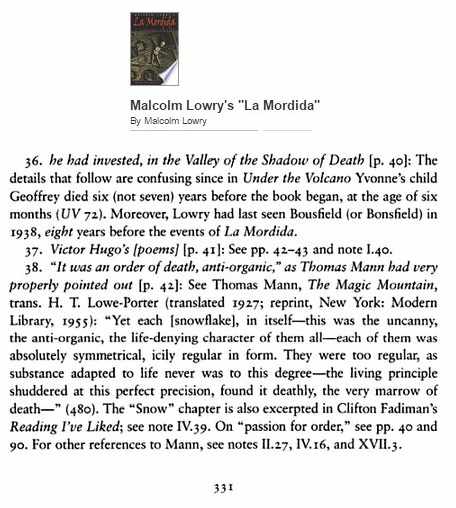

Thursday, August 7, 2014
The Omega Mystery
See a post, The Omega Matrix, from the date of her death.
Related material:
"When Death tells a story, you really have to listen."
— Cover of The Book Thief

A scene from the film of the above book —

“Looking carefully at Golay’s code is like staring into the sun.”
Some context — "Mathematics, Magic, and Mystery" —
See posts tagged April Awareness 2014.
Friday, July 11, 2014
Back to 1955
Nick Fury takes the Tesseract…
… which travels back to 1955
(see The Call Girls, Nov. 3, 2013)…
Above: A 1955 cover design by Robert Flynn.
Images from December 1955…
… and a fictional image imagined in an earlier year:
Thursday, March 13, 2014
Story
A Presbyterian meditation —

A scene from the film of the above book —

“Looking carefully at Golay’s code is like staring into the sun.”
For more of the story, see Golay in this journal.
Tuesday, December 24, 2013
Through a Mirror, Darkly
Review of a book first published in 1989—
Reality's Mirror: Exploring the Mathematics of Symmetry —
"Here is a book that explains in laymen language
what symmetry is all about, from the lowliest snowflake
and flounder to the lofty group structures whose
astonishing applications to the Old One are winning
Nobel prizes. Bunch's book is a marvel of clear, witty
science writing, as delightful to read as it is informative
and up-to-date. The author is to be congratulated on
a job well done." — Martin Gardner
A completely different person whose name
mirrors that of the Mathematics of Symmetry author —
See also this journal on the date mentioned in the Princetonian .
"Always with a little humor." — Yen Lo
Monday, October 21, 2013
Edifice Complex
New! Improved!
"Euclid's edifice loomed in my consciousness
as a marvel among sciences, unique in its
clarity and unquestionable validity."
—Richard J. Trudeau in
The Non-Euclidean Revolution (First published in 1986)
Readers of this journal will be aware that Springer's new page
advertising Trudeau's book, pictured above, is a bait-and-switch
operation. In the chapter advertised, Trudeau promotes what he
calls "the Diamond Theory of Truth" as a setup for his real goal,
which he calls "the Story Theory of Truth."
For an earlier use of the phrase "Diamond Theory" in
connection with geometry, see a publication from 1977.
Saturday, April 13, 2013
Narrative
"… both marveled at early Ingmar Bergman movies."
One of the friends' "humor was inspired by
surrealist painters and Franz Kafka."
"Most of Marvel's fictional characters operate in
a single reality known as the Marvel Universe…."


Related material: The Cosmic Cube.
Wednesday, September 19, 2012
Art Wars (continued)
Today's previous post, "For Odin's Day," discussed
a mathematical object, the tesseract, from a strictly
narrative point of view.
In honor of George Balanchine, Odin might yield the
floor this evening to Apollo.
From a piece in today's online New York Times titled
"How a God Finds Art (the Abridged Version)"—
"… the newness at the heart of this story,
in which art is happening for the first time…."
Some related art—
and, more recently—
This more recent figure is from Ian Stewart's 1996 revision
of a 1941 classic, What Is Mathematics? , by Richard Courant
and Herbert Robbins.
Apollo might discuss with Socrates how the confused slave boy
of Plato's Meno would react to Stewart's remark that
"The number of copies required to double an
object's size depends on its dimension."
Apollo might also note an application of Socrates' Meno diagram
to the tesseract of this afternoon's Odin post—
For Odin’s Day*
(Mathematics and Narrative, continued)
| "My dad has a great expression," Steve Sabol told USA TODAY Sports last year. "He always says, 'Tell me a fact, and I'll learn. Tell me the truth, and I believe. But tell me a story, and it will live in my heart forever.' " |
Fact—
Truth—
An art gallery in Oslo is exhibiting a tesseract.
Story—
The Jewel of Odin's Treasure Room
* I.e., Wednesday. For some apt Nordic spirit,
see Odin's Day 2012 Trailer.
Thursday, September 13, 2012
Backstory
Yesterday's online Los Angeles Times
on a film that inspired recent protests in Cairo—
The film… was shown on June 23
to an audience of less than 10
at a theater on Hollywood Boulevard,
a source familiar with the screening said….
The screening was at The Vine Theater,
which rents itself out for private screenings,
said one person involved in the theater.
An image from this journal on that same day, June 23—

Source: Rudolf Koch, The Book of Signs
For some background on the symbol, see Damnation Morning.
See also Don Henley's Hollywood hymn "Garden of Allah."
Update of 8 PM Sept. 13, 2012—
Other sources give the film's screening date not as June 23,
2012, but rather as June 30, 2012. (BBC News, LAWEEKLY blogs)
The following post from this journal on that date may or
may not have some religious relevance.
| Saturday, June 30, 2012
Filed under: Uncategorized — m759 @ 7:20 PM "… to snare the spirits of mankind in nets of magic" — The aim of the artist, according to Thomas Wolfe Related entertainment— High-minded— Many Dimensions . Not so high-minded— The Cosmic Cube . |
Saturday, June 30, 2012
Snares
"… to snare the spirits of mankind in nets of magic"
— The aim of the artist, according to Thomas Wolfe
Related entertainment—
High-minded— Many Dimensions .
Not so high-minded— The Cosmic Cube .
Friday, January 27, 2012
Mathematics and Narrative (continued)
Princeton University Press on a book it will publish in March—
Circles Disturbed: The Interplay of Mathematics and Narrative
"Circles Disturbed brings together important thinkers in mathematics, history, and philosophy to explore the relationship between mathematics and narrative. The book's title recalls the last words of the great Greek mathematician Archimedes before he was slain by a Roman soldier— 'Don't disturb my circles'— words that seem to refer to two radically different concerns: that of the practical person living in the concrete world of reality, and that of the theoretician lost in a world of abstraction. Stories and theorems are, in a sense, the natural languages of these two worlds–stories representing the way we act and interact, and theorems giving us pure thought, distilled from the hustle and bustle of reality. Yet, though the voices of stories and theorems seem totally different, they share profound connections and similarities."
Timeline of the Marvel Cinematic Universe — Norway, March 1942—
"The Red Skull finds the Tesseract, a cube of strange power,
said to be the jewel of Odin’s treasure room, in Tonsberg Norway.
(Captain America: The First Avenger)"
Tesseracts Disturbed — (Click to enlarge)
Detail of Tesseracts Disturbed —

Narrative of the detail—
See Tesseract in this journal and Norway, May 2010—
Sunday, January 22, 2012
The Presbyterian Exorcist
(Backstory— Presbyterian in this journal)
Princeton University Press on a book it will publish in March—
Circles Disturbed brings together important thinkers in mathematics, history, and philosophy to explore the relationship between mathematics and narrative. The book's title recalls the last words of the great Greek mathematician Archimedes before he was slain by a Roman soldier–"Don't disturb my circles"–words that seem to refer to two radically different concerns: that of the practical person living in the concrete world of reality, and that of the theoretician lost in a world of abstraction. Stories and theorems are, in a sense, the natural languages of these two worlds–stories representing the way we act and interact, and theorems giving us pure thought, distilled from the hustle and bustle of reality. Yet, though the voices of stories and theorems seem totally different, they share profound connections and similarities.
Exercise— Discuss the above paragraph's vulgarity.
Discuss also the more robust vulgarity of Marvel Entertainment…
Context— "Marvel" in this journal, and The Cosmic Cube.
Sunday, August 28, 2011
The Cosmic Part
Yesterday's midday post, borrowing a phrase from the theology of Marvel Comics,
offered Rubik's mechanical contrivance as a rather absurd "Cosmic Cube."
A simpler candidate for the "Cube" part of that phrase:

The Eightfold Cube
As noted elsewhere, a simple reflection group* of order 168 acts naturally on this structure.
"Because of their truly fundamental role in mathematics,
even the simplest diagrams concerning finite reflection groups
(or finite mirror systems, or root systems—
the languages are equivalent) have interpretations
of cosmological proportions."
— Alexandre V. Borovik in "Coxeter Theory: The Cognitive Aspects"
Borovik has a such a diagram—

The planes in Borovik's figure are those separating the parts of the eightfold cube above.
In Coxeter theory, these are Euclidean hyperplanes. In the eightfold cube, they represent three of seven projective points that are permuted by the above group of order 168.
In light of Borovik's remarks, the eightfold cube might serve to illustrate the "Cosmic" part of the Marvel Comics phrase.
For some related theological remarks, see Cube Trinity in this journal.
Happy St. Augustine's Day.
* I.e., one generated by reflections : group actions that fix a hyperplane pointwise. In the eightfold cube, viewed as a vector space of 3 dimensions over the 2-element Galois field, these hyperplanes are certain sets of four subcubes.
Wednesday, August 17, 2011
Marginal Remarks
Today's Google Doodle is in honor of Fermat's birthday—

"I have discovered a truly marvelous proof of this theorem,
which this doodle is too small to contain." — Google's caption
Another marginal remark, from a link target in last night's "Ein Kampf"—
"We are talking about the spatial and temporal phenomenon of language,
not about some non-spatial, non-temporal chimera [Note in margin:
Only it is possible to be interested in a phenomenon in a variety of ways]."
— Ludwig Wittgenstein, Philosophical Investigations (1953), Section 108
Related material on spatial and temporal phenomena—
A Dec. 29, 2010, comment to a Dec. 26 weblog post on
"Unexpected Connections in Mathematics"—

Connoisseurs of synchronicities in the phenomena of language may note that
these December dates mark the feasts of St. Stephen and St. Thomas Becket.
From the feast of the latter, two Log24 posts: Toy Stories and True Grid.
Those less enchanted by pop math than Google may prefer to observe
two other birthdays today— those of Robert De Niro and of Sean Penn:
Tuesday, May 10, 2011
Groups Acting
The LA Times on last weekend's film "Thor"—
"… the film… attempts to bridge director Kenneth Branagh's high-minded Shakespearean intentions with Marvel Entertainment's bottom-line-oriented need to crank out entertainment product."
Those averse to Nordic religion may contemplate a different approach to entertainment (such as Taymor's recent approach to Spider-Man).
A high-minded— if not Shakespearean— non-Nordic approach to groups acting—
"What was wrong? I had taken almost four semesters of algebra in college. I had read every page of Herstein, tried every exercise. Somehow, a message had been lost on me. Groups act . The elements of a group do not have to just sit there, abstract and implacable; they can do things, they can 'produce changes.' In particular, groups arise naturally as the symmetries of a set with structure. And if a group is given abstractly, such as the fundamental group of a simplical complex or a presentation in terms of generators and relators, then it might be a good idea to find something for the group to act on, such as the universal covering space or a graph."
— Thomas W. Tucker, review of Lyndon's Groups and Geometry in The American Mathematical Monthly , Vol. 94, No. 4 (April 1987), pp. 392-394
"Groups act "… For some examples, see
- The 2×2×2 Cube,
- The Diamond 16 Puzzle,
- The Diamond Theorem, and
- Finite Geometry of the Square and Cube.
Related entertainment—
High-minded— Many Dimensions—

Not so high-minded— The Cosmic Cube—

One way of blending high and low—
The high-minded Charles Williams tells a story
in his novel Many Dimensions about a cosmically
significant cube inscribed with the Tetragrammaton—
the name, in Hebrew, of God.
The following figure can be interpreted as
the Hebrew letter Aleph inscribed in a 3×3 square—
The above illustration is from undated software by Ed Pegg Jr.
For mathematical background, see a 1985 note, "Visualizing GL(2,p)."
For entertainment purposes, that note can be generalized from square to cube
(as Pegg does with his "GL(3,3)" software button).
For the Nordic-averse, some background on the Hebrew connection—
Saturday, May 7, 2011
Bridges
|
24 Frames column in the LA Times Critical Mass: 'Thor' swings his hammer and the critics scream May 6, 2011 | 2:55 pm
Bridges are the key theme of this weekend's "Thor," a film that bridges us from the doldrums of spring releases to the flashier, if not better, world of summer blockbusters. It also serves as another step in the bridge from the first "Iron Man" in 2008 to next summer's superhero all-star jam, "The Avengers." And within the film itself, a superhero actioner about the Norse god of thunder and his adventures in his home of Asgard and on Earth, a rainbow bridge connects the well-regarded Asgard sections of the film with the less successful Earth sections, set in Puente Antiguo, N.M. (which means "Old Bridge"). According to Times critic Kenneth Turan, the film also attempts to bridge director Kenneth Branagh's high-minded Shakespearean intentions with Marvel Entertainment's bottom-line-oriented need to crank out entertainment product. — Patrick Kevin Day |
Related material: Kate and Thor in The Turning and A Bridge Too Far.
Saturday, December 4, 2010
Damnation on 42nd Street
Yesterday's New York Lottery— Midday 042, Evening 919.
Here 042 may be seen as referring to New York's 42nd Street…
Below, West 42nd St., facing north, from yesterday's New York Times—

Related material —
- Yesterday's Star of Venus
 in the post Black Swan
in the post Black Swan
- Damnation Morning in this journal (with a version of the above symbol)
- "Damnation Morning" (the original story)
That story is part of the Change War saga by Fritz Leiber, notably represented by Leiber's 1957 novel The Big Time.
See also Comic Book Resources on the new comic-book series Spider-Man: Big Time—
CBR: “Big Time” is this title of this new era of “Amazing Spider-Man.” Why choose that title? What exactly is it referring to?
DAN SLOTT: “Big Time” refers to more than “Amazing Spider-Man,” it also refers to other Spider-Projects: “Astonishing Spider-Man/Iron Man,” the new Norman Osborn mini, and the all-new “Spider-Girl!” With “Amazing,” “Big Time” takes on a lot of meanings. In this book, everything is bigger: bigger stakes for Peter Parker, bigger threats for Spider-Man, and a much bigger comic. We are expanding to 30 pages of material, twice a month!
As for yesterday's evening NY lottery number 919, see 9/19.
Friday, August 7, 2009
Friday August 7, 2009
Angel and Beast
Screenwriter Frank Pierson spoke at
Chautauqua Institution this morning.
The gist of his remarks may be found
in an undated graduation speech
at WarnerSisters.com.
His suggested motto for filmmakers:
"To reach and touch
the angel in the beast."
The Chautauquan Daily,
Friday, August 7, 2009
by Sara Toth, staff writer —
"Pierson listed his favorite movies as the Italian and French films that, after World War II, captivated him and his friends. 'Those movies were overwhelmingly fascinating to us, and changed the way in which we saw movies, and the way we saw our lives and what we wanted to do with ourselves,' he said. 'There were so many that were absolutely marvelous.' Such movies are not made any more, Pierson said, and the quality of the movies now pale in comparison to those of the 1970s and 1980s. About once a year, the Coen brothers release a movie, and Woody Allen 'occasionally' makes a good film, Pierson said. But the mainstream movies that are shown in the multiplexes now are geared toward only one audience: young men with disposable incomes. 'That's really catering so extensively to a rather limited audience-- a mentally retarded and emotionally stunted audience at that-- that there's not a lot left over for the rest of us,' Pierson said."
Tuesday, August 5, 2008
Tuesday August 5, 2008

The Last Theorem, a novel by
Arthur C. Clarke and Frederik Pohl
"The Last Theorem is a story of one man’s mathematical obsession, and a celebration of the human spirit and the scientific method. It is also a gripping intellectual thriller….
In 1637, the French mathematician Pierre de Fermat scrawled a note in the margin of a book about an enigmatic theorem: 'I have discovered a truly marvelous proof of this proposition which this margin is too narrow to contain.' He also neglected to record his proof elsewhere. Thus began a search for the Holy Grail of mathematics– a search that didn’t end until 1994, when Andrew Wiles published a 150-page proof. But the proof was burdensome, overlong, and utilized mathematical techniques undreamed of in Fermat’s time, and so it left many critics unsatisfied– including young Ranjit Subramanian, a Sri Lankan with a special gift for mathematics and a passion for the famous 'Last Theorem.'
When Ranjit writes a three-page proof of the theorem that relies exclusively on knowledge available to Fermat, his achievement is hailed as a work of genius, bringing him fame and fortune…."
For a similar third-world fantasy about another famous theorem, see the oeuvre of Ashay Dharwadker.
Note the amazing conclusion of Dharwadker's saga (thus far)–
Dharwadker devises a proof of the four-color theorem that leads to…
of the Standard Model
with Quantum Gravity!
and Usenet Postings.
For another connection with Sri Lanka, see
Saturday, July 14, 2007
Saturday July 14, 2007
Catholic University
of America
The August 2007 issue of Notices of the American Mathematical Society contains tributes to the admirable personal qualities and mathematical work of the late Harvard professor George Mackey. For my own tributes, see Log24 on March 17, 2006, April 29, 2006, and March 10, 2007. For an entry critical of Mackey’s reductionism– a philosophical, not mathematical, error– see Log24 on May 23, 2007 (“Devil in the Details”).
Here is another attack on reductionism, from a discussion of the work of another first-rate mathematician, the late Gian-Carlo Rota of MIT:
“Another theme developed by Rota is that of ‘Fundierung.’ He shows that throughout our experience we encounter things that exist only as founded upon other things: a checkmate is founded upon moving certain pieces of chess, which in turn are founded upon certain pieces of wood or plastic. An insult is founded upon certain words being spoken, an act of generosity is founded upon something’s being handed over. In perception, for example, the evidence that occurs to us goes beyond the physical impact on our sensory organs even though it is founded upon it; what we see is far more than meets the eye. Rota gives striking examples to bring out this relationship of founding, which he takes as a logical relationship, containing all the force of logical necessity. His point is strongly antireductionist. Reductionism is the inclination to see as ‘real’ only the foundation, the substrate of things (the piece of wood in chess, the physical exchange in a social phenomenon, and especially the brain as founding the mind) and to deny the true existence of that which is founded. Rota’s arguments against reductionism, along with his colorful examples, are a marvelous philosophical therapy for the debilitating illness of reductionism that so pervades our culture and our educational systems, leading us to deny things we all know to be true, such as the reality of choice, of intelligence, of emotive insight, and spiritual understanding. He shows that ontological reductionism and the prejudice for axiomatic systems are both escapes from reality, attempts to substitute something automatic, manageable, and packaged, something coercive, in place of the human situation, which we all acknowledge by the way we live, even as we deny it in our theories.”
— Robert Sokolowski, foreword to Rota’s Indiscrete Thoughts
 Fr. Robert Sokolowski, Ph.D., is Professor of Philosophy at The Catholic University of America in Washington, D.C. Ordained a Roman Catholic priest in 1962, he is internationally recognized and honored for his work in philosophy, particularly phenomenology. In 1994, Catholic University sponsored a conference on his work and published several papers and other essays under the title, The Truthful and the Good, Essays In Honor of Robert Sokolowski. |
The tributes to Mackey are contained in the first of two feature articles in the August 2007 AMS Notices. The second feature article is a review of a new book by Douglas Hofstadter. For some remarks related to that article, see Thursday’s Log24 entry “Not Mathematics but Theology.”
Monday, June 19, 2006
Monday June 19, 2006
Snippets:
A Reply to John Updike
See Updike on digitized snippets.
The following four snippets were pirated from the end of MathPages Quotations, compiled by Kevin Brown.
They are of synchronistic interest in view of the previous two Log24 entries, which referred (implicitly) to a Poe story and (explicitly) to Pascal.
"That is another of your odd notions,"
said the Prefect, who had the fashion
of calling everything 'odd' that was
beyond his comprehension, and thus
lived amid an absolute legion of 'oddities.'
Edgar Allan Poe
I knew when seven justices could not
take up a quarrel, but when the parties
were met themselves, one of them
thought but of an If, as, 'If you said so,
then I said so'; and they shook hands
and swore brothers. Your If is the only
peacemaker; much virtue in If.
Shakespeare
I have made this letter longer than usual
because I lack the time to make it shorter.
Blaise Pascal
S'io credessi che mia risposta fosse
a persona che mai tornasse al mondo,
questa fiamma staria senza piu scosse.
Ma per cio che giammai di questo fondo
non torno vivo alcun, s'i'odo il vero,
senza tema d'infamia ti rispondo.
Dante, 1302
For translations of the Dante (including one by Dorothy Sayers), see everything2.com.
An anonymous author there notes that Dante describes a flame in which is encased a damned soul. The flame vibrates as the soul speaks:
If I thought that I were making
Answer to one that might return to view
The world, this flame should evermore
cease shaking.
But since from this abyss, if I hear true,
None ever came alive, I have no fear
Of infamy, but give thee answer due.
-- Dante, Inferno, Canto 27, lines 61-66,
translated by Dorothy Sayers
“Yes, there is a ton of information on the web but much of it is grievously inaccurate, unedited, unattributed and juvenile. The electronic marvels that abound around us serve, I have the impression, to inflame what is most informally and non-critically human about us. Our computer screens stare back at us with a kind of giant, instant aw-shucks, disarming in its modesty.”
Note Updike’s use of “inflame.”
For an aw-shucks version of “what is most informally and non-critically human about us,” as well as a theological flame, see both the previous entry and the above report from Hell.
Note that the web serves also to correct material that is inaccurate, unedited, unattributed, and juvenile. For examples, see Mathematics and Narrative. The combination of today’s entry for Pascal’s birthday with that web page serves both to light one candle and to curse the darkness.
Thursday, January 26, 2006
Thursday January 26, 2006
On Beauty
“Something beautiful fills the mind yet invites the search for something beyond itself, something larger or something of the same scale with which it needs to be brought into relation. Beauty, according to its critics, causes us to gape and suspend all thought. This complaint is manifestly true: Odysseus does stand marveling before the palm; Odysseus is similarly incapacitated in front of Nausicaa; and Odysseus will soon, in Book 7, stand ‘gazing,’ in much the same way, at the season-immune orchards of King Alcinous, the pears, apples, and figs that bud on one branch while ripening on another, so that never during the cycling year do they cease to be in flower and in fruit. But simultaneously what is beautiful prompts the mind to move chronologically back in the search for precedents and parallels, to move forward into new acts of creation, to move conceptually over, to bring things into relation, and does all this with a kind of urgency as though one’s life depended on it.”

The above symbol of Apollo suggests, in accordance with Scarry’s remarks, larger structures. Two obvious structures are the affine 4-space over GF(3), with 81 points, and the affine plane over GF(32), also with 81 points. Less obvious are some related projective structures. Joseph Malkevitch has discussed the standard method of constructing GF(32) and the affine plane over that field, with 81 points, then constructing the related Desarguesian projective plane of order 9, with
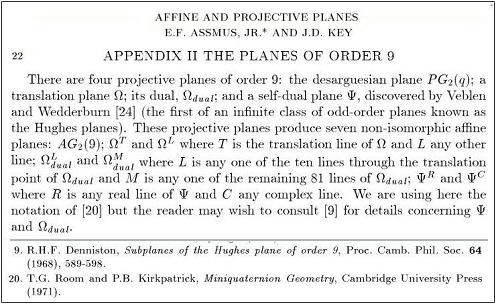
Miniquaternion geometry: An introduction to the study of projective planes, by T. G. Room and P. B. Kirkpatrick. Cambridge Tracts in Mathematics and Mathematical Physics, No. 60. Cambridge University Press, London, 1971. viii+176 pp.
For “miniquaternions” of a different sort, see my entry on Visible Mathematics for Hamilton’s birthday last year:

Wednesday, November 16, 2005
Wednesday November 16, 2005
"The best of the books are the ones… where the allegory is at a minimum and the images just flow."
"'Everything began with images,' Lewis wrote…."
"We go to the writing of the marvellous, and to children’s books, for stories, certainly, and for the epic possibilities of good and evil in confrontation, not yet so mixed as they are in life. But we go, above all, for imagery: it is the force of imagery that carries us forward. We have a longing for inexplicable sublime imagery…."
"The religious believer finds consolation, and relief, too, in the world of magic exactly because it is at odds with the necessarily straitened and punitive morality of organized worship, even if the believer is, like Lewis, reluctant to admit it. The irrational images– the street lamp in the snow and the silver chair and the speaking horse– are as much an escape for the Christian imagination as for the rationalist, and we sense a deeper joy in Lewis’s prose as it escapes from the demands of Christian belief into the darker realm of magic. As for faith, well, a handful of images is as good as an armful of arguments, as the old apostles always knew."
Click on pictures for details.
See also Windmills and
Verbum sat sapienti?
as well as
at Calvin College
on Simone Weil,
Charles Williams,
Dante, and
"the way of images."
Sunday, April 11, 2004
Sunday April 11, 2004
Good Friday and
Descartes’s Easter Egg
“The use of z, y, x . . . to represent unknowns is due to René Descartes, in his La géometrie (1637)…. In a paper on Cartesian ovals, prepared before 1629, x alone occurs as unknown…. This is the earliest place in which Descartes used one of the last letters of the alphabet to represent an unknown.”
— Florian Cajori, A History of Mathematical Notations. 2 volumes. Lasalle, Illinois: The Open Court Publishing Co., 1928-1929. (Vol. 1, page 381)
This is from
http://members.aol.com/jeff570/variables.html.
Descartes’s Easter Egg is found at
EggMath: The Shape of an Egg —
Cartesian Ovals.
An Easter Meditation
on Humpty Dumpty
The following is excerpted from a web page headed “Catholic Way.” It is one of a series of vicious and stupid Roman Catholic attacks on Descartes. Such attacks have been encouraged by the present Pope, who today said “may the culture of life and love render vain the logic of death.”
The culture of life and love is that of the geometry (if not the philosophy) of Descartes. The logic of death is that of Karol Wojtyla, as was made very clear in the past century by the National Socialist Party, which had its roots in Roman Catholicism.
|
Humpty Dumpty sat on a wall. “In the century just completed, the human race found itself in a position not unlike the scrambled mess at the base of an imaginary English wall…. … we are heirs to a humanity that is broken, fractured, confused, unsure of what to make of itself…. … ‘postmodernism’ is merely the articulation of the fractured, dissipated state of the human being…. Without relating a history of modern philosophy, our unfortunate human shell has suffered a continual fragmentation for a period of roughly 500 years. (You philosophers out there will recognize immediately that I am referring to the legacy of René Descartes.) And this fragmentation has been a one-way street: one assault after another on the integrity and dignity of the human person until you have, well, the 20th Century. But now it’s the 21st Century. The beauty … the marvel … the miracle of our time is the possibility that gravity will reverse itself: Humpty Dumpty may be able, once again, to assume his perch.” — Ted Papa, |
Voilà.

The upper part
of the above icon
is from EggMath.
For the lower part,
see Good Friday.
Sunday, March 14, 2004
Sunday March 14, 2004
Clarity and Certainty
“At the age of 12 I experienced a second wonder of a totally different nature: in a little book* dealing with Euclidean plane geometry, which came into my hands at the beginning of a schoolyear. Here were assertions, as for example the intersection of the three altitudes of a triangle in one point, which — though by no means evident — could nevertheless be proved with such certainty that any doubt appeared to be out of the question. This lucidity and certainty [Klarheit und Sicherheit] made an indescribable impression upon me…. For example I remember that an uncle told me the Pythagorean theorem before the holy geometry booklet* had come into my hands. After much effort I succeeded in ‘proving’ this theorem on the basis of the similarity of triangles … for anyone who experiences [these feelings] for the first time, it is marvellous enough that man is capable at all to reach such a degree of certainty and purity [Sicherheit und Reinheit] in pure thinking as the Greeks showed us for the first time to be possible in geometry.”
— from “Autobiographical Notes” in Albert Einstein: Philosopher-Scientist, edited by Paul Arthur Schilpp
“Although our intellect always longs for clarity and certainty, our nature often finds uncertainty fascinating.”
— Carl von Clausewitz at Quotes by Clausewitz
For clarity and certainty, consult All About Altitudes (and be sure to click the “pop it up” button).
For murkiness and uncertainty, consult The Fog of War.
Happy birthday, Albert.
* Einstein’s “holy geometry booklet” was, according to Banesh Hoffman, Lehrbuch der Geometrie zum Gebrauch an höheren Lehranstalten, by Eduard Heis (Catholic astronomer and textbook writer) and Thomas Joseph Eschweiler.
Thursday, January 29, 2004
Thursday January 29, 2004
Misunderstanding
in the Theory of Design
"Whether or not we can follow the theorist in his demonstrations, there is one misunderstanding we must avoid at all cost. We must not confuse the analyses of geometrical symmetries with the mathematics of combination and permutation….
The earliest (and perhaps the rarest) treatise on the theory of design drives home this insight with marvellous precision."
— E. H. Gombrich, 1979, in
The Sense of Order
This is perhaps the stupidest remark I have ever read. The "treatise on the theory of design" that Gombrich refers to is
- Dominique Douat, Méthode Pour Faire une Infinité de Desseins Differents…. Paris, 1722.
For some background, see
Truchet & Types:
Tiling Systems and Ornaments, and
Certain of the Truchet/Douat patterns have rather intriguing mathematical properties, sketched in my website Diamond Theory. These properties become clear if and only if we we do what Gombrich declares that we must not do: "confuse the analyses of geometrical symmetries with the mathematics of combination and permutation." (The verb "confuse" should, of course, be replaced by the verb "combine.")
Saturday, August 16, 2003
Saturday August 16, 2003
My Personal Thorny Crown
Kirk Varnedoe, 57, art historian and former curator of the Museum of Modern Art, died Thursday, August 14, 2003.
From his New York Times obituary:
" 'He loved life in its most tangible forms, and so for him art was as physical and pleasurable as being knocked down by a wave,' said Adam Gopnik, the writer and a former student of his who collaborated on Mr. Varnedoe's first big show at the Modern, 'High & Low.' 'Art was always material first — it was never, ever bound by a thorny crown of ideas.' "
For some background on the phrase "thorny crown of ideas," see the web page
The phrase "thorny crown of ideas" is also of interest in the light of recent controversy over Mel Gibson's new film, "The Passion."
For details of the controversy, see Christopher Orlet's Aug. 14 essay at Salon.com,
For a real "thorny crown of ideas," consider the following remarks by another art historian:
"Whether or not we can follow the theorist in his demonstrations, there is one misunderstanding we must avoid at all cost. We must not confuse the analyses of geometrical symmetries with the mathematics of combination and permutation….
The earliest (and perhaps the rarest) treatise on the theory of design drives home this insight with marvellous precision."
— E. H. Gombrich, 1979, in
The Sense of Order
This is perhaps the most stupid remark I have ever read. The "treatise on the theory of design" that Gombrich refers to is
- Dominique Douat, Methode pour faire une infinité de desseins differents avec des carreaux mipartis de deux couleurs par une ligne diagonale : ou observations du Pere Dominique Douat Religieux Carmes de la Province de Toulouse sur un memoire inséré dans l'Histoire de l'Académie Royale des Sciences de Paris l'année 1704, présenté par le Reverend Sebastien Truchet religieux du même ordre, Academicien honoraire, imprimé chez Jacques Quillau, Imprimeur Juré de l'Université, Paris 1722.
This is the title given at the web page
Truchet & Types:
Tiling Systems and Ornaments,
which gives some background.
Certain of the Truchet/Douat patterns have rather intriguing mathematical properties, sketched in my website Diamond Theory. These properties become clear if and only we we do what Gombrich moronically declares that we must not do: "confuse the analyses of geometrical symmetries with the mathematics of combination and permutation." (The verb "confuse" should, of course, be replaced by the verb "combine.")
What does all this have to do with
As jesting Pilate seems to have realized, whenever Jews (or, for that matter, Christians) tell stories, issues of truth may arise. Such issues, as shown by current events in that damned Semitic Hell-on-Earth that used to be referred to as "the Holy Land," can be of life-and-death importance.

Scene from
The Passion
The Roman soldiers may have fashioned a physical crown of thorns, but the Jews are quite capable of fashioning a very uncomfortable crown of, as Gopnik says, "ideas."
Here is an example.
"Ernst Hans Josef Gombrich, who as an author went by the name E. H. Gombrich, was born in Vienna in 1909….
The Gombrich family was Jewish, but his parents felt this had no particular relevance. In later years Mr. Gombrich said that whether someone was Jewish or not was a preoccupation for the Gestapo."
— Michael Kimmelman's obituary for Gombrich in the New York Times. Kimmelman is chief art critic for the New York Times and author of the Times's Aug. 15 Varnedoe obituary.
The web page Understanding cited above contains a link to
Pilate, Truth, and Friday the Thirteenth,
a page combining some religious remarks with a quotation of an extremely patronizing and superficial reference to my own work (and, in passing, to Truchet/Douat patterns).
This reference, and the above-quoted remark by Gombrich, constitute my own modest claim to what the Jew Gopnik jokingly calls a "thorny crown of ideas."
To me it is no joke.
This partly accounts for the rather strained quality of the attempt at humor in a web page I put together yesterday in response to Varnedoe's obituary:
Another reason for the strained quality is my being struck by the synchronicity of reading Varnedoe's obituary shortly after I had done a journal entry related to the death in July of an earlier Museum of Modern Art curator. Like Robert A. Heinlein, I think the God of the Jews is a lousy deity and an even worse father figure. I do, however, believe in synchronicity.
Saturday, December 7, 2002
Saturday December 7, 2002
ART WARS:
Shall we read?
From Contact, by Carl Sagan:
“You mean you could decode a picture hiding in pi
and it would be a mess of Hebrew letters?”
“Sure. Big black letters, carved in stone.”
He looked at her quizzically.
“Forgive me, Eleanor, but don’t you think
you’re being a mite too… indirect?
You don’t belong to a silent order of Buddhist nuns.
Why don’t you just tell your
story?”

From The Nation – Thailand
Sat Dec 7 19:36:00 EST 2002:
New Jataka books
blend ethics and art
Published on Dec 8, 2002
“The Ten Jataka, or 10 incarnations of the Lord Buddha before his enlightenment, are among the most fascinating religious stories….
His Majesty the King wrote a marvellous book on the second incarnation of the Lord Buddha…. It has become a classic, with the underlying aim of encouraging Thais to pursue the virtue of perseverance.
For her master’s degree at Chulalongkorn University’s Faculty of Arts, Her Royal Highness Princess Maha Chakri Sirindhorn wrote a dissertation related to the Ten Jataka of the Buddha. Now with the 4th Cycle Birthday of Princess Sirindhorn approaching on April 2, 2003, a group of artists, led by prominent painter Theeraphan Lorpaiboon, has produced a 10-volume set, the “Ten Jataka of Virtues”, as a gift to the Princess.
Once launched on December 25, the “Ten Jataka of Virtues” will rival any masterpiece produced in book form….”
“How much story do you want?”
— George Balanchine
Monday, August 5, 2002
Monday August 5, 2002
History, Stephen said….
— To really know a subject you've got to learn a bit of its history….
We both know what memories can bring;
They bring diamonds and rust.
All sorts of structures that can be defined for finite sets have analogues for the projective geometry of finite fields….
Clearly this pattern is trying to tell us something; the question is what. As always, it pays to focus on the simplest case, since that's where everything starts.
In the beginning was the word….
— The Gospel according to Saint John
The anonymous author of John makes liberal use of allegory and double-entendre to illustrate this theme.
Born yesterday: Logician John Venn.
Venn considered three discs R, S, and T as typical subsets of a set U. The intersections of these discs and their complements divide U into 8 nonoverlapping regions….
— History of Mathematics at St. Andrews
Who would not be rapt by the thought of such marvels?….
